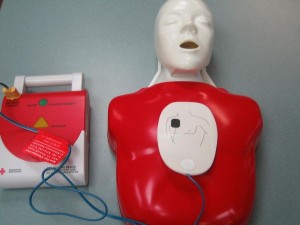
When the heart abruptly stops beating, it is called cardiac arrest. Cardiac arrest is one of the leading causes of deaths in the United States. Some of the famous people who died of cardiac arrest include Michael Jackson, Christopher Reeve, Brittany Murphy and Tim Russert. Treatments for cardiac arrest include cardiopulmonary resuscitation (CPR) and the use of automated external defibrillator (AED). If the abrupt loss of heart function is not immediately returned, cardiac arrest can easily lead to bereavement. For every minute the heart’s normal beating is not restored the victim’s chance for survival decreases by seven to ten percent.
To perform CPR, one only needs to remember the CAB priorities. Early CPR has proven to save lives. However, the less popular and harder to do is the AED. The automated external defibrillator is a light, portable device which carries out electrical shock from the machine through the chest and into the heart. The electric shock is capable of ceasing arrhythmia, or irregular beating of the heart, and allowing the heart to return to its normal rhythm.
Although it is important to note that not all arrhythmias are revivable by AED. When there is ventricular fibrillation or ventricular tachycardia in the heart, or heart rhythm in chaos or very fast heart rhythm, respectively, electric shock can lead to restoring normal heart rhythm. Conversely, when there is normal electrical recording but no blood flow or pulseless electrical activity (PEA), or asystole (flat line) or no electrical activity at all, the heart is not “shockable,” and defibrillation will not be able to treat these kinds of arrhythmias. AEDs are able to determine whether defibrillation is needed.
Before operating an AED on anyone, ensure that the person is unconscious. Shout and shake the person to check for a response. If the casualty is an infant or young child, pinch the skin and never shake. If pulse is irregular or absent, prepare to operate AED immediately. Ensure that the person is in a safe and dry area and take away any metal necklaces or underwire bra. If there is extra chest hair, trim with the scissors or razor found in AED kit. AED pads should be positioned at least one inch away from piercings or implanted medical device.
If possible, use pediatric AED for anyone eight and below. If none is available, an adult AED may be used. Turn on the AED and wipe the
chest dry. Attach the pads. If essential, plug in the connector. No one should be touching the person at all times. If essential, press the “analyze” button. If shock is recommended, press the “shock” button. Begin or continue chest compressions. Follow AED prompts.
Gaining CPR skills and learning how to use AEDs could help save a life. It must be noted that only trained individuals can are allowed to operate AEDs. Learning first Aid/ CPR/ AED courses and earning certifications gives you these skills to help save a life. Gaining the aforementioned skills is applicable in the daily lives as an emergency can happen anytime, anywhere. Being a professional responder can make a great difference in helping a victim.
